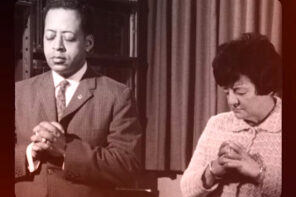As Luke Coppen noted in a recent piece in The Spectator, Francis “has been spun as a left-liberal idol,” in the popular media. There is reason to believe, however, that conservatives are also misappropriating Francis when convenient and spinning his words in service to their own agendas. Such conservative efforts have resulted in Francis contributing, if inadvertently, to a growing and increasingly global yogaphobia.
In a homily at a morning mass on January 9 in the Santa Marta residence, Francis reflected on that day’s gospel reading, which described how the apostles were frightened when they witnessed Jesus walking on water. The Pope explained that they were afraid as a consequence of their hearts being hardened. He went on to list a variety of potential reasons why peoples’ hearts might become hardened, such as a painful experience from a person’s past, religious narcissism or “creating a world within oneself, all closed in,” or insecurity and fear “that something painful or sad will occur.”
Francis asserted that the Holy Spirit is the only thing with the power to open peoples’ hearts to God. Most significantly perhaps, he stated a person can take a thousand catechism courses, spirituality courses, yoga courses, or zen courses, but none of those things would free the person to be like a child of God. Only the Holy Spirit, according to Francis, has the power to break the hardness of the heart and make it docile toward God and free to love.
Given the frequent Catholic and evangelical yogaphobic moments in recent history, I asked myself if the Pope’s remarks were yogaphobic, but I concluded that yogaphobia did not appear to be at play in Francis’ homily. The Pope, after all, listed yoga alongside catechism classes and so did not set it apart as a practice that Catholics should avoid altogether, as a practice that is incompatible with an authentic Catholic identity.
Rather, he seems to have suggested that nothing, not even formal religious classes offered by the Catholic Church itself, could facilitate a loving disposition without a personal relationship with the so-called Holy Spirit. Since yoga was not set apart from Catholic practices in this regard, I did not think it made a notable contribution (or any contribution for that matter) to yogaphobia.
But that Francis did not appear to target yoga as an inherently flawed or problematic practice at odds with Catholicism did not deter Father Roland Colhoun, a Catholic priest from Northern Ireland, from co-opting and misconstruing Francis’ remarks in service to Colhoun’s own yogaphobic agenda. And Colhoun’s yogaphobia is a part of a much larger conservative movement.
There have been many high-profile examples of evangelical yogaphobia (I have written about some of them here and here), but evangelicals are not the only players in the yogaphobic movement. Fr. Colhoun’s comments concerning yoga were not dissimilar from other yogaphobic remarks from contemporary high-profile Catholics whose positions have ranged from identifying yoga as self-destructive activity to associating it with Satan.
Back in 1989, the Congregation for the Doctrine of the Faith (CDF) of the Roman Catholic Church published the “Letter to the Bishops of the Catholic Church on Some Aspects of Christian Meditation” warning of the “dangers and errors” of fusing Christian and non-Christian meditative methods. The letter was written by Cardinal Joseph Ratzinger (later Pope Benedict XVI) and was approved for publication by Pope John Paul II.
Understandably, the CDF seeks to prevent Catholics from undermining Church doctrine, yet the letter is fear-inciting insofar as it addresses so-called eastern body practices, which are deemed incompatible with Catholic doctrine as well as destructive of human stability. The letter warns that those engaged in such practices for the sake of anything beyond mundane physical exercise or relaxation are involved in self-destructive activity; that unless the practitioner is an advanced adept no bodily experiences can be legitimately identified as spiritual; and points out that Christians who have acknowledged the meditative role of body practices avoid the “exaggerations and partiality” of eastern methods, which are often recommended to those insufficiently prepared.
It adds that postures and breathing can become an “idol and thus an obstacle” to experiencing God, then states that such body practices “can degenerate into a cult of the body” with severe consequences, including “mental schizophrenia,” “psychic disturbance,” or “moral deviations.” More recently, in 2011, Italian priest and chief exorcist for the Diocese of Rome Gabriele Amorth warned that yoga is satanic and “leads to evil.” And, in 2014, in County Donegal, Ireland, Father Padraig O’Baoill warned his parishioners against “endangering” their souls by practicing yoga, which he suggested was “unsavoury.”
Colhoun joins this yogaphobic maelstrom and, unfortunately, drags Francis in with him. He recently warned that yoga leads to the “Kingdom of Darkness” and draws people toward “Satan and the fallen angels” by distorting the words of Francis:
Pope Francis said ‘do not seek spiritual answers in yoga classes’. Yoga is certainly a risk. There’s the spiritual health risk. When you take up those practices from other cultures, which are outside our Christian domain, you don’t know what you are opening yourself up to. The bad spirit can be communicated in a variety of ways. I’m not saying everyone gets it, or that it happens every time, and people may well be doing yoga harmlessly, but there‘s always a risk and that’s why the Pope mentioned it and that’s why we talk about that in terms of the danger of the new age movement and the danger of the occult today. That’s the fear.
The real fear, however, is not that yoga will make you self-destruct or worship Satan. No evidence supports such conclusions. The reasonable fear, rather, is that yogaphobia is becoming so ubiquitous that it no longer surprises us when otherwise innocuous comments by powerful, high-profile individuals, such as the Pope, are misappropriated and put in service of identity politics meant to justify an agenda to prevent social, political, and religious boundary crossing.
Just as Coppen notes in response to liberal fantasies about Francis, “What matters is what the real Francis says and does. And that should be more interesting than even the most gripping invention.” Catholics and others should attend to the actual words Francis used in his January 9 homily.
At the same time, despite the efforts of some Hindus who have urged Francis to denounce Colhoun for his public yogaphobia, Francis has not acted. The Pope might not have expressed yogaphobia, but neither has he denied the legitimacy of Colhoun’s statements. And, unfortunately, we can expect real social consequences when people invent stories about a person revered by over a billion people worldwide.




